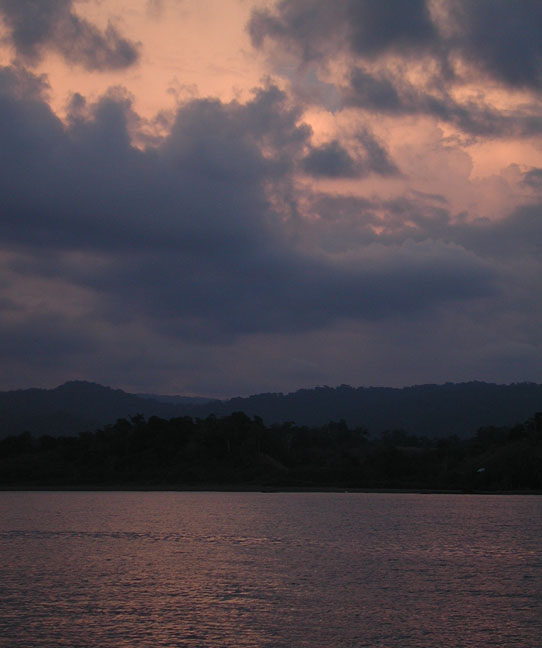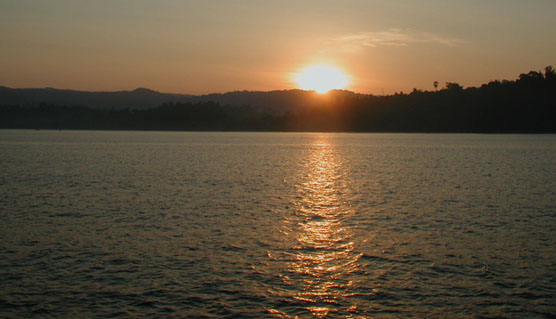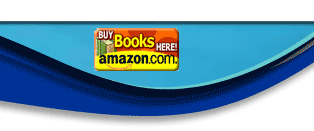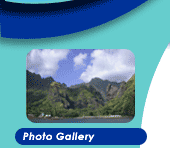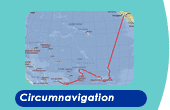March
18, 2001
|
We are motoring in calm seas with only a six-knot wind. It has been a peaceful day since we left the fishing village of Puerto Jiménez at 6:00 AM. We left Golfo Dulce and rounded Cabo Matapalo, enjoying the seaside view of the Peninsula de Osa that we had trekked in just yesterday. About 10:00 AM, after making up a batch of chicken pasta salad and avocado dip before the salon heated up in the heat of the day, I was already sweaty and ready for a cold water sponge bath. Just as I splashed the refreshing water all over me, I heard a thump against the side of the starboard hull right outside the master head. I immediately ran out, naked, to the starboard helm. The depth meter read sixty feet, and I saw no logs floating in the water. “What could have made that strange thumping sound,” I thought. Just then I noticed the back of a huge sea turtle, swimming away from the starboard hull. We must have hit him a little, but he was slowing proceeding along, apparently not hurt. The sailors call these turtles “speed bumps.” We had seen quite a few before, but never hit one. Mostly, we had spotted them early because of the sea birds calmly riding on their backs. A collision against the props can cause trouble, as one can imagine! There are four sea turtles common to Costa Rican waters: The smallest is the Olive Ridley Turtle, with adults weighing up to 45 kg (100 lbs.) and measuring up to 75 cm (2’6”). The back of the head, shell, and flippers vary from dark green to bright yellow, but most of them are olive green. The plate protecting the bottom of the body is yellow. These turtles travel far offshore. Their food consists of shrimp, crab, sea urchins and snails, for which they may have to dive as much as 150 m (almost 500’). Their nesting sites are along this stretch of the Costa Rican coast. An awesome spectacle here is the arribada, when thousands of turtles clamber ashore in a frenzied search for a nesting site. Some turtles are injured in the foray, many nests and their contents are destroyed and the beach becomes an egg-spattered war zone in the process! Bahia Huevos is actually named after such a nesting site, huevos meaning eggs in Spanish. A medium-sized turtle, the Hawksbill, weighs from 35 to 75 kg (77 to 165 lbs) and measures from 65 to 95 cm (26” to 36”). The backs of the adults have steaks of reddish-brown, black and yellow on an amber background. These turtles are seldom seen here outside of their nesting areas; one being Playa Curu. This species of turtle is considered endangered. Its shell has been used for ornaments and jewelry; in Mexico and Japan, juvenile Hawksbills are polished and used as wall hangings. The Pacific Green Turtle is larger than the olive ridley, averaging about 80 cm (32”) in length and weighing from 65 to 125 kg (143 to 275 lbs.). Its shell (carapace) is very narrow, highly arched, smooth, and narrows toward the rear. The hatchlings have a dark grey/green carapace. This turns to brown spots as juveniles and to medium brown to dark olive as adults. Some green turtles are famous for their extensive migrations; those, which feed off the coast of Brazil, swim to nesting beaches on Ascension Island, some 1400 miles distant. PacificCoast green turtles, however, appear to live year-round in the same general area. All of the green turtles are classified as endangered largely through decimation for the restaurant trade in the U.S. and Europe. Though protected, many nests are destroyed by poachers in search of eggs for sale as food and as an ingredient in cosmetics. Then there is the giant leatherback. It has a huge body that is shaped like a barrel, encased in black leathery skin, with five ridges. The leatherback is the largest marine turtle and in fact, the largest reptile in the world today. These monsters of the sea grow from 1.5 to 2 m (5 to 7’) and weigh from 260 to 600 kg (700 to 1600 lbs.) Leatherbacks are amazing creatures. They can be found nesting on tropical beaches bordering the Atlantic, Pacific, and IndianOceans. In the non-nesting season, they travel as far north as Canada,Iceland, and Norway and as far south as New Zealand and Peru. (They can maintain a body temperature up to 10 degrees centigrade above that of the surrounding water.). They can travel as much as 6,000 km (2,727 miles) to feed in waters as deep as 500 m (1,640’). Their primary food is jellyfish. Leatherbacks are still exploited for their oil, which at one time was used as a caulking material for wooden vessels. Now it is used in cosmetics and as lamp fuel. Although they are the second most frequently seen turtle in Costa Rica, I was certain that what I saw was not a leatherback. I am assuming it was the smaller olive ridley, also quite common in these parts. We arrived at Drake’s Bay at 4:00 PM, after 61.5 miles of motoring, after an otherwise uneventful day. We enjoyed a sundowner and chips with our fresh guacamole dip (I’m addicted!) and then sat on the net to enjoy a fantastic evening light show over the bay. This was one of these evenings where the setting sun in the west over the Pacific is the minor attraction, but look the other way and WOW!
March 19, 2001 Today, as we motored from Drake’s Bay to Quepos, I positively identified a leatherback. He was unmistakable, his huge barrel-like shell protruding over the glassy sea. Fortunately, I had my binoculars out. I had been sitting out at the starboard pulpit seat, scanning the horizon for fishing nets. We had encountered no less than four fishing vessels and three buoys since leave Drake’s Bay at dawn this morning. And there he was, lumbering along a few yards away!
Leaving Drake’s Bay at Sunrise
|
journal32.html |
|
|
